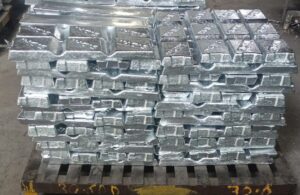Zamak
SIDHI Manufactures the complete range of zinc die casting alloys. The name ZAMAK draws upon the basic metallurgy of the alloy group: Z-Zinc, A-Aluminum, MA-Magnesium, and K-Kopper (e.g., German). ZAMAK 3 is the most common alloy for hot chamber die casting. With a combination of superior mechanical properties and low melting/manufacturing costs, it fulfills the needs of most die casting applications.
Other ZAMAK alloys include ZAMAK 2, ZAMAK 5, and ZAMAK 7. Common to each alloy is a consistent Aluminum content range, however, the alloys differ in specification by varying amounts of copper, magnesium, and nickel – resulting in different mechanical and physical properties.
Why Choose Us?
- In house Spectro analysis
- We don’t use scrap material
- We produce zamak from SHG
- We can produce special analysis zamak
- Competitive Prices

| Zamak-3 | No. 3 alloy is usually the first choice when considering zinc die casting. Its excellent balance of desirable physical and mechanical properties, superb castability and long-term dimensional stability are the reasons why over 70% of all North American zinc die castings are in No. 3 alloy. It is, therefore, the most widely available alloy from die casting sources. ZAMAK No. 3 also offers excellent finishing characteristics for plating, painting and chromate treatments. It is the “standard” by which other zinc alloys are rated in terms of die casting. |
|---|---|
| Zamak 5 | No. 5 alloy castings are marginally stronger and harder than No. 3. However, these improvements are tempered with a reduction in ductility which can affect formability during secondary bending, riveting, swaging or crimping operations. No. 5 contains an addition of 1% copper which accounts for these property changes. The alloy is widely die cast in Europe and does exhibit excellent castability characteristics, as well as, improved creep performance over No. 3. Because of No. 3’s wide availability, material specifiers often strengthen components by design modifications instead of using No. 5. However, when an extra measure of tensile performance is needed, No. 5 alloy castings are recommended. The alloy is readily plated, finished and machined, comparable to No. 3 alloy. |
| Zamak 2 | No. 2 is the only ZAMAK alloy which is used for gravity casting; mainly for metal forming dies or plastic injection tools. This alloy is sometimes referred to as Kirksite. For die casting, No. 2 offers the highest strength and hardness of the ZAMAK family. However, its high copper content (3%) results in property changes upon long term aging. These changes include slight dimensional growth (0.0014 in/in/after 20 yrs.), lower elongation and reduced impact performance (to levels similar to aluminum alloys) for die cast products. Although No. 2 alloy exhibits excellent castability, it has seen limited use by die casters in North America. It does, however, provide some interesting characteristics which may assist designers. Its creep performance is rated higher than the other ZAMAKs and No. 2 maintains higher strength and hardness levels after long term aging. Also, preliminary investigations suggest No. 2 alloy is a good bearing material, and may eliminate bushings and wear inserts in die cast designs. |
| ZA-8 | A good gravity casting alloy, ZA-8 is rapidly growing for pressure die casting. ZA-8 can be hot chamber die cast, with improved strength, hardness and creep properties over ZAMAK’s, with the exception of a No. 2 alloy which is very similar in performance. ZA-8 is readily plated and finished using standard procedures for ZAMAK. When the performance of standard No. 3 or No. 5 is in question, ZA-8 is often the die casting choice because of high strength and creep properties and efficient hot chamber castability. |
| ZA-12 | ZA-12 is the most versatile zinc alloy in terms of combining high performance properties and ease of fabrication using either gravity or pressure die casting. ZA-12 is the best gravity casting alloy for sand, permanent mold and the new graphite mold casting process. It is also a good pressure die casting alloy (cold chamber) which provides a sounder structure than ZA-27, as well as higher die cast elongation and impact properties. For these reasons, die cast ZA-12 often competes with ZA-27 for strength application. An excellent bearing alloy, ZA-12 is also platable, although plating adhesion is reduced compared to the ZAMAK alloys. |
Zamak Chemistry & Physics
| Alloying Elements(%) | ZA-3 | ZA-2 | ZA-8 | ZA-12 | ZA-27 | |
|---|---|---|---|---|---|---|
| Al | 3.9 – 4.3 | 3.9 – 4.3 | 8.0 – 8.8 | 10.50 – 11.50 | 25.00 – 28.00 | |
| Cu | 0.75 – 1.25 | 2.5 – 3.5 | 0.80 – 1.30 | 0.50 – 1.25 | 2.00 – 2.50 | |
| Mg | 0.04 – 0.06 | 0.04 – 0.08 | 0.01 – 0.03 | 0.01 – 0.03 | 0.01 – 0.02 | |
| Impurities | Fe | 0.100 M | 0.075 M | 0.100 M | 0.080 M | 0.100 M |
| Cd | 0.002 M | 0.002 M | 0.002 M | 0.002 M | 0.002 M | |
| Sn | 0.002 M | 0.002 M | 0.002 M | 0.002 M | 0.002 M | |
| Pb | 0.003 M | 0.003 M | 0.003 M | 0.003 M | 0.003 M | |
| Zamak-3 | Zamak-2 | Zamak-8 | Zamak-12 | Zamak-27 | |
|---|---|---|---|---|---|
| Brinel Hardness | 91 | 100 | |||
| Melting Point 0C | 405 | 390 | 404 | 432 | 484 |
| Density kg/m3 | 6700 | 6 | 6300 | 6000 | 5000 |
| Tensile Strength (psi) | 48000 | 54000 | 58000 | 61000 |
